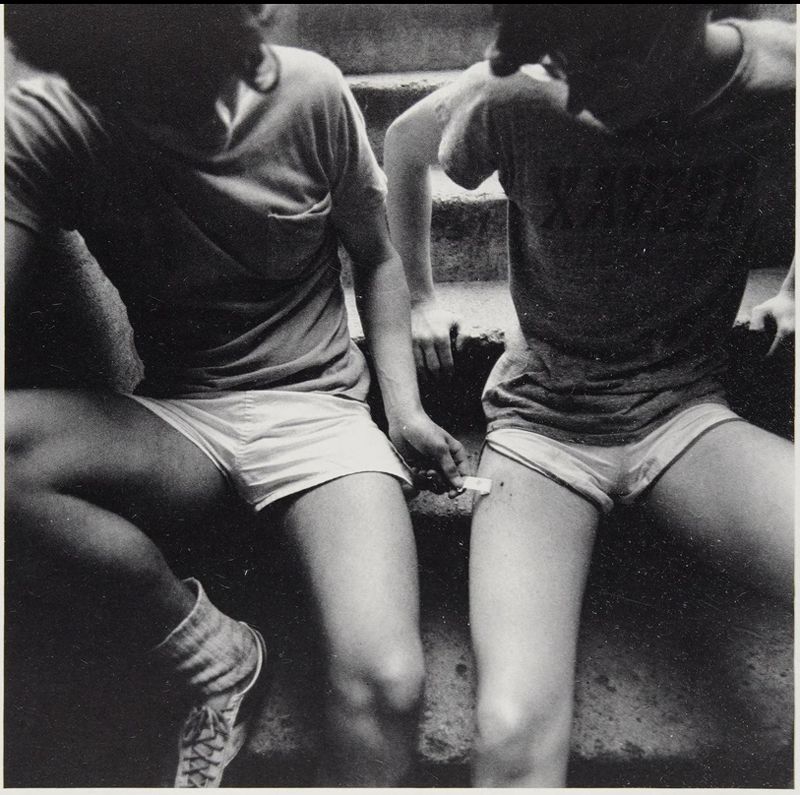 |
| Arthur Tress, Facing Up. |
Browsing photography books on a recent rainy day I flipped through a book titled Facing Up by photographer Arthur Tress. I had not heard of him before and had never seen any of his photographs. It was an exciting bit of discovery to find something unfamiliar and immediately love it like in my younger days of looking across a dance floor and finding love at two in the morning.
Tress is a gay male American photographer born in Brooklyn in 1940. His first experience with a camera came at the age of twelve, taking photographs in Coney Island and this is where he began developing his own eye for framing the world in photographs. He studied painting and graduated from Bard before moving to Paris and traveling to Asia, Africa, Mexico and around Europe. Returning to the U.S., he photographed the civil rights movement of the 60s, politics and the Beatles. For the rest of his career he has photographed urban decay, children, life in Appalachia, male nudes and many other subjects that appear in his numerous books and in the collections of museums.
He was a peer and competitor of the more well known Robert Mapplethorpe. Tress' work is much more varied and interesting than Mapplethorpe, who seemed to be obsessed with orchids and sticking objects up his own ass and the asses of others. There is a place for Mapplethorpe, his work and his admirers (count me as one), but even as someone who has stood in museums and admired the stunning work hanging on a wall at close range, I do not get any sense of soaring or delightful inspiration from his work. Mapplethorpe, without fail, leaves me cold.
 |
| Arthur Tress, Facing Up. |
 |
| Arthur Tress, Facing Up. |
 |
| Arthur Tress, Facing Up. |
By contrast, the male nudes by Tress in Facing Up are playful, fun, imaginative and still retain their eroticism without relying on vulgarity to shock a viewer. I get a sense of humor behind the photographs that dulls the edgy seriousness of the skill that it took to pose the models and shoot them. The intimacy between the eye behind the camera and subject feels natural.
 |
| Arthur Tress, Facing Up. |
 |
| Arthur Tress, Facing Up. |
 |
| Arthur Tress, Facing Up. |
The photos in this book were shot in the late 1970s. Tress lived on the west side of Manhattan near the abandoned Christopher Street Piers along the Hudson River that have since became infamous in gay history before the AIDS epidemic. The piers were a place where gay men would nude sun bathe, cruise for sex, do drugs, and engage in prostitution among other elicit activities. Among those ruins, artists such as Peter Hujar and David Wojnarowicz would create their art and find inspiration. It was Tress who introduced Wojnarowicz to the piers. Not in this book, but of note is that Tress also photographed in the cruising grounds of The Rambles in Central Park in the more secretive era of the mid 1960s.
 |
| Arthur Tress, Facing Up. |
 |
| Arthur Tress, Facing Up. |
Facing Up was first published in 1980 and again in 2004. If you can find a copy then grab it. Out of his long career and the accolades that he has received, it appears that his photos of gay life have been the least exhibited and the least appreciated. His photos of gay life deserve more recognition. Stanford University does host an online collection of seventy of his photographs, including some of the nudes from Facing Up, here titled Gay Fantasies.
There is a recent documentary that has been made about Arthur Tress titled Arthur Tress: Water's Edge. Unfortunately, it does not appear to be widely available and I have not seen it.
Further reading about Arthur Tress: an excellent, lengthy interview with him from 1999.








